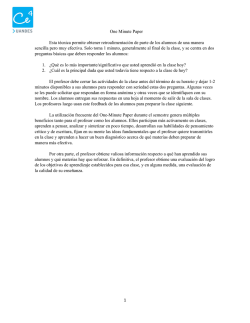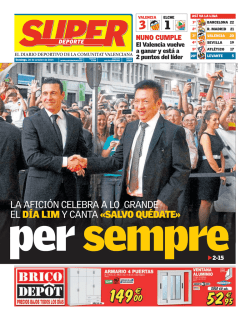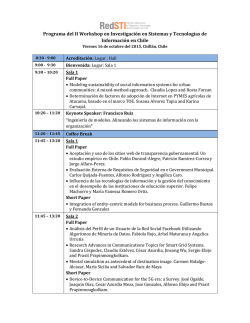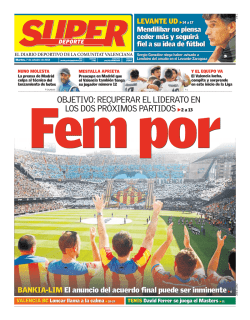
33th IPH CONGRESS - Asociación Hispánica de Historiadores del
Organized by/Organizan: In collaboration with/Colaboran: 33 IPH CONGRESS IN VALENCIA “The Paper Road from Xàtiva and Valencia to the Mediterranean countries and to the New World” "La Ruta del Papel desde Xàtiva y Valencia a los países Mediterráneos y al Nuevo Mundo” Universitat de València. Aula Magna Tuesday, 20th September/Martes, 20 de Septiembre 16.00 h. Arrivals / registration / document hand out/Llegada/Registro/Entrega de documentación 17.00 h. Opening of the conference/Apertura del Congreso 18.00-18:30 h. A proposal to classify early european papers according to technological criteria. Peter Tschudin 18:30-19.00 h. Bark cloth as writing material and its importance for the history of paper. AnnaGrethe Rischel 19.00 h. Welcome drink/Bebida de Bienvenida 19:30-20:00 h. Concert at the chapel of the University of Valencia/Concierto en la Capilla de la Universidad 1 Wednesday, 21st September/Miércoles 21 de Septiembre ROOM 1/SALA 1 Technological development of paper as a material for writing, printing, painting, wrapping and other purposes / El desarrollo tecnológico del papel como material para escribir, imprimir, pintar, embalar y otros fines. 9:00-9:30 h. El papel como materia prima en la realización de esculturas ligeras. Un ejemplo: la Virgen de los Desamparados del S. XV de la Basílica de Valencia / The paper as a raw material in the realization of light sculptures. An example: la Virgen de los Desamparados from the 15th century in the Basilica of Valencia. Rosa M. Román Garrido y Julián Otero. 9:30-10.00 h. El papel como soporte y estructura de la escultura religiosa cristiana / Paper as element in christian religious sculpture. Daniel Benito Goerlich, María Gómez Rodrigo y Francisco Javier Hernández Gracia 10.00-10:30 h. Usos sociales de papel sellado en la América española (Chile, siglo XVIII)/ Social uses of the stamped paper in Spanish America (Chile, 18th Century). Aude Argouse 10:30-11:00 h. Los soportes de papel y cartón en la obra pictórica de Amadeo Modigliani / The paper and cardboard supports in the Amedeo Modigliani paintings. Greta García Hernández 11:00-11:30 h. Coffee break/Pausa café 11:30-12:00 h. Las marcas tipográficas en el taller de Juan Mey (Valencia 1535-1566)/ Tipographical marks at the workshop of Juan Mey (Valencia, 1535-1566). Alejandrina Aguas 12:00-12:30 h. Papel para imprimir: selección, usos y procedencias en la Península Ibérica en los siglos XV y XVI/ Paper for printing: selection, uses and provenance in the Iberian Peninsula in the 15th and 16th Centuries. Manuel José Pedraza Gracia 12:30-13:00 h. El papel de los papeles en la encuadernación: tipología de su uso en las encuadernaciones artísticas de la Biblioteca de la Real Academia de Bellas Artes de San Fernando / The role of the papers in the binding: typology of his use in the artistic bindings of the Library of the Royal Academy of San Fernando's Fine arts. Antonio Carpallo Bautista y Yohana Yessica Flores Hernández 13.00-13:30 h. «Ex vetulis pannis tenuem contexto papyrum ». Premières études sur le papier à Milan /«Ex vetulis pannis tenuem contexto papyrum ». Early studies on Milan’s paper. Katia Toia 13:30-14:00 h. El estudio de un libro novohispano perteneciente al Archivo General de Andalucía (Sevilla)/The study of a novohispano relate of General Archive of Andalusia (Seville).Elena Vázquez Jiménez, Javier Bueno Vargas y Francisco M. Puente-Herrera Macías. 14:00-15:30 h. Lunch time/Comida 2 15:30-16:00 h. Estudiando el estudio: el uso de cuadernos de apuntes como herramienta para estudiar la educación/Studying the study: using notebooks to understand education.Jocelyn Alcántara-García 16:00-16:30 h. Les Jésuites dans la Nouvelle-France: analyse des documents du XVIIe siècle conservés à Bibliothèque et Archives Canada / Jesuits in New France: analysis of documents from 17th century in the collections of Library and Archives Canada. Geneviève Samson y Céline Gendron 16:30-17:00 h. Relaciones en la manera de hacer papel durante los siglos XIV y XV en los países del Mediterráneo: descripción y análisis / The papermaking connections during the XIVth and XVth century in Mediterranean countries: description and analysis. Carmen Sistach 17:00-17:30 h. La instalación de las primeras fábricas de papel en la ciudad de Río de Janeiro, Brasil, en el siglo XIX / The establishment of the first paper factories in the city of Rio de Janeiro during the 19th century. Thais Helena Almeida y Ozana Hannesch 17:30-18:00 h. La manufactura papelera valenciana en la Edad Moderna / Valencian paper manufacture in the Modern Age. Federico Verdet Gómez ROOM 2/SALA 2 The invention of watermarks and their importance for the studies of provenance, dating and trade of European paper / La invención de la filigrana y su importancia para el estudio de procedencia, datación y comercio del papel europeo 9:00-9:30 h. Filigranas de los libros del siglo XVIII de la Biblioteca del Museo Nacional de Cerámica de Valencia /Watermarks of 18th century books in the library of the National Museum of Ceramics from Valencia. Carmen Rodrigo Zarzosa 9:30-10:00 h. Filigranas de los siglos XIX y XX en Santander (España) / Watermarks in 19th and 20th centuries in Santander (España). Carmen María Alonso Riva 10:00-10:30 h. Apuntes sobre una filigrana singular de los siglos XVII y XVIII documentada en archivos valencianos (Real Colegio-Seminario del Corpus Christi de Valencia y Archivo Municipal de Alicante) / Notes on a unique watermark of the seventeenth and eighteenth centuries documented in Valencia files (Royal College-Seminary of the Corpus Christi in Valencia and the Municipal Archive in Alicante).Marta Soliva 10:30-11:00 h. The same or not the same: watermarks and their variants. María Stieglecker 11:00-11:30 h. Coffee break/Pausa café 11:30 -12:00 h. Fresh view on Norwegian historical papers and their watermarks. Chiara Palandri y Nina Hesselberg-Wang 12:00-12:30 h. Recording Norwegian papers and watermarks: executive procedure. Dafne Diamante y Caterina Margheri 12:30-13:00 h. The web platform of the watermarks of the corpus Chartarum Italicarum. Alessandra Fucini 3 13.-13:30 h. Nuevas aportaciones en la base de datos on-line FIL DPZ / New contributions in the online database FIL-DPZ. Susana Morales Ramírez (coordinadora), Ana Ballestero Pascual, Alicia Bayona Casas, Laura Casaus Magro, Raúl Martínez Laguna, Keti Nicolaeva Atanasova, Sara Peiró Prades, Joanna Redondo Vázquez y Gema Sancho Monllor. 13:30-14:00 h. One decade of a watermark portal-retrospection and preview. Emanuel Wenger 14:00-15:30 h. Lunch time/Comida 15:30 -16:00 h. XVIIIth century watermarks research: the enigma of Jean-Jacques Rousseau’s ‘golden paper’. Claire Bustarret 16:00-16:30 h. The roll of watermarks in a choir book. Silvia Salgado y Argentina Enríquez Arana 16:30-17:00 h. El corpus de filigranas hispánicas / The corpus of spanish watermarks. Mª del Carmen Hidalgo Brinquis y Celia Diez Esteban 17:00-17:30 h. Estudio de las filigranas en la obra “Las Glorias de María” / Study of the watermarks in the work “The Glories of Mary”. Patricia Gómez Gómez 17:30-18:00 h. Así pudo ser la maquinaria de un molino de papel / That could be the machine of a paper mill. Emilio Guadalajara 18:00-20:00 h. Valencia tourist bus tour (Valencia, beaches and harbor) / Tour turístico en autobús por Valencia (ciudad, puerto y playas) Thursday, 22nd September/Jueves 22 de Septiembre 8:00 h. Trip to Xàtiva: Sant Domènec Church, The Colegiata and the Fine Arts Museum / Visita a Xàtiva: Iglesia de Sant Domènec, La Colegiata y Museo de Bellas Artes 14:00 h. Lunch in Banyeres de Mariola/Comida en Banyeres de Mariola 16:00 h. Visit to Banyeres de Mariola: the Castle, the Valencian Paper Museum and the Mill’s Route BIC / Visita al Castillo, al Museo Valenciano del Papel y a la Ruta de los Molinos.BIC. 19:00 h. Departure to Valencia / Regreso a Valencia Friday, 23rd September/Viernes 23 de Septiembre ROOM 1/SALA 1 Contributions of relevance for the international studies of the history paper/Aportaciones de relevancia para el estudio internacional de la historia del papel of 9:00-9:30 h. Chinese Paper used for European Books published in the 16th to 18th centuries. ENAMI Kazuyuki, OKADA Yoshihiro, ISHIZUKA Harumichi, XU Xiaojie, SHINOZAKI Yoko y YAMAMURA Yoshiteru 9:30-10:00 h. Tibetan papermaking traditions reconstructed from the results of the fibre analyses of the Mustang archival documents. Agnieszka Helman - Wazny 4 10:00-10:30 h. Lost research from the early 1940’s on the technological history of Oriental paper. Alexandra Balachenkova y Denis Olegovich Tsypkin 10:30-11:00 h. Characteristics of Korean Print Books. KIM Heakyoung, OKADA Yoshihiro y ENAMI Kazuyuki 11:00-11:30 h. Coffee break 11:30-12:00 h. Voyage d'un miroir et d'un lot de papiers trouvés dans le grenier de ma tante à Shiraz en Iran / The travels of a mirror and a bunch of papers found in my aunt’s attic in Iran. Marie-Christine Enshaian 12:00-12:30 h. Methodological guide for the identification of asian papers. Claude Laroque, Michela Bussotti, Agnieszka Helman-Ważny y Anna-Grethe Rischel 12:30-13:00 h. Avigdor Arikha and his papers: from East to West. Léon-Bavi Vilmont y Natalie Coural 13:00-13:30 h. Paper and the social elite in Early Modern England. Mark Bland 13:30-14:00 h. The beginnings of the gaelic paper manuscript. Pádraig Ó Macháin 14:00-15:30 h. Lunch time 15:30-16:00 h. New elements of industrial archeology: the history of the Celano’s paper mill between the XVII and the XVIII century. Rosella Graziaplena 16:00-16:30 h. Molinos papeleros de la familia, localizaciones y marcas de la fábrica de la zona de Alcoy / Papermills of the family, locations and brands of factory in Alcoy’s zone. José Merita 16:30-17:00 h. Bibliofilia y pervivencia de la memoria escrita. El papel de la Societat Bibliogràfica Valenciana Jerònima Galés / Bibliophilia and survival of the written memory. The role of the Societat Bibliogràfica Valenciana Jerònima Galés. Miguel C. Muñoz Feliu, Aránzazu Guerola, José Luis Marco y Rafael Solaz ROOM 2/SALA 2 Analysis, conservation and preservation of papers of importance as bearer of our cultural heritage / Análisis, conservación y preservación de documentos como portadores de nuestro patrimonio cultural 9:00-9:30 h. Restauración y estudio de los libros notariales de la primera mitad del siglo XV de Sant Joan de les Abadesses, Girona / Restoration and study of the first half of the fifteenth century notarial books from Sant Joan de les Abadesses, Girona. Mª Dolores Díaz-Miranda Macías 9:30-10:00 h. Deterioros del papel hispanoárabe: El Protocolo notarial de Artús de Colent (1365-1388) / Deterioration on Arabic paper: The notary protocol by Artús de Colent (13651388). Susana González 5 10-10:30 h. Proceso de restauración del plano de la acequia real del Júcar grabado por Roxas en el siglo XVIII en el museu municipal d’Alzira-muma: estudio y proceso de intervención. Patricia Real Machado y José Ignacio Catalán Martí 10:30-11:00 h. Pautas para la digitalización de los estarcidos. La colección de los estarcidos de la Real Fabrica de loza de Alcora del Museo de Bellas Artes de Castellón. Una propuesta metodológica / Guideliness for the digitization of the stencils. The collection of the stencils from the Royal Factory of Alcora of the Museo de Bellas Artes de Castellón. A methodological Proposal. Pascual Mercé 11-11:30 h. Coffee break/Pausa Café 11:30-12:00 h. Comportamiento del azul de índigo frente a los tratamientos de blanqueo en documentos gráficos / Indigo blue behavior against bleaching treatments in graphic documents. Natalia Tello, Ana Mª López Montes y Mª del Rosario Blanc García 12:30-13:00 h. Analysis of two resin impregnated papers used for tracing by Augustin Ehrensvärd in the late 1720´s. Kathleen Mühlen Axelsson 13:00-13:30 h. Thermal Paper: a historical and technical approach / El papel térmico: una aproximación histórica y técnica. Salvador Muñoz Viñas, Ester Antón García y Sara Ruiz de Diego 13:30-14:00 h. Heritage, in particular archival material on paper. Patricia Engel, Tamilselvan Mohan, Rupert Kargl y Volker Ribitsch 14:00-15:30 h. Lunch time/Comida 15:30 -16:00 h. Uso del papel coreano Hanji en la restauración de documentos. La creación del grupo de investigación: The Group 130º Paper Conservador. Use of the Korean mulberry paper Hanji in book and paper conservation. The Group 130º Paper Conservador. Elisa Diaz y Sara Ortego Boldo 16:00-16:30 h. La obra gráfica de José Peris Aragó: estudio, catalogación y estado de conservación. Flor Cuartero Revaliente 16:30-17:00 h. Digitalización 3D, Scanner 3D, Diagnóstico del estado de conservación/ 3D digitalization, Scanner 3D, Diagnostic of the State of Conservation. Juan Pérez, Cristina Valero y Gemma Mª Contreras 17:00 h. Conclusions / Conclusiones 17:30 h. IPH General Assembly / Asamblea General del IPH 17:30 h. Visit to the Museo Nacional de Cerámica y Artes Suntuarias González Martí - Marqués de Dos Aguas Palace and the Royal College Seminar of Corpus Christi Archives and Library / Visita al Museo Nacional de Cerámica y Artes Suntuarias González Martí - Palacio del Marqués de Dos Aguas y al Real Colegio Seminario de Corpus Christi de Valencia, Archivo de Protocolos. 20:30 h. Dinner at The Fine Arts Museum of Valencia / Cena en el Museo de Bellas Artes de Valencia 6 POSTERS NanoRestArt; Nanomateriales para la restauración de obras de arte: el caso de soportes celulósicos / NanoRestArt-Nano-materials for the Restoration of works of Art: The case of cellulosic materials. Elena González, Isabel Lozano, Susana Marras y Emma Sánchez A miniature book of Arabic incantations. Arantxa Guerola y Marisa Ferrando Cusí Estampa de Nuestra Señora de los Desamparados: Estudio y Conservación. Patricia Real y José Ignacio Catalán Martí The special paper decoration technique declined in Middle Age in the Japanese papermaking history. KATSUHIKO Masuda Dibujo sobre papel. Conservación preventiva en estado puro. Irene Rodríguez y Carolina Mai Cerovaz Intervención en libros afectados por catástrofes del Archivo Municipal de Vila-real / Interventions in books affected by disasters coming from the Archivo Municipal de Vilareal. Ángel Calderón Rodríguez, Gemma María Candel Rodríguez e Iván Soler Muñoz El adhesivo de vejiga de esturión y su aplicación en la restauración del patrimonio documental y bibliográfico. Javier Bueno Vargas y Elena Vázquez Jiménez Arte de Furtar: the watermarks of an apocryphal work. Carla Valente Saturday, 24th September/Sábado 24 de Septiembre 9:00 h. Trip to Bunyol / Visita a Buñol: Visit to Castle and San Luis/ Visita al Castillo y San Luis. Buñol: Reception at the Library (ancient Paper Mill Galán) / Recepción en la Biblioteca (antiguo Molino Galán) Buñol: Visit to paper mill industrial archaeology and a paper mill /Visita a molinos papeleros, arqueología industrial y a molino papelero en actividad. 14.30 h. Lunch: Paella at Mesón Venta Pilar (Valencian paella done with fuelwood)/ Comida: Paella en el Mesón Venta Pilar. Closing of the Congress / Clausura del Congreso 17:00 h. Departure to Valencia / Regreso a Valencia • The organizers reserve the right to change the programme in case of unexpected events / La organización se reserva el derecho a modificar el programa en caso de acontecimientos inesperados. 7
© Copyright 2026



